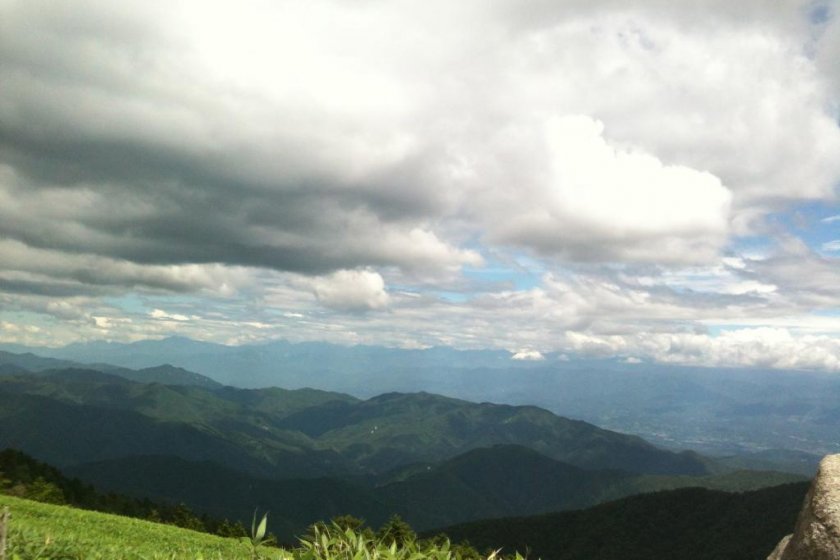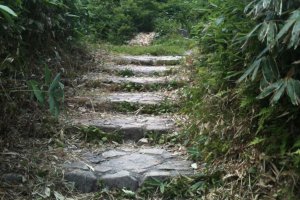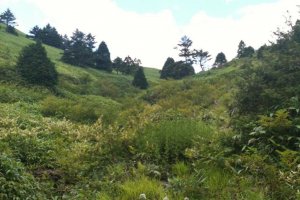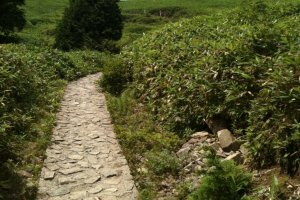The sun was shining, a light breeze was blowing and I was feeling like a hike. There wasn’t a ton of time but I was near one of Nakatsugawa’s most popular hiking locations, Fujimidai Highlands. Located only about forty minutes from downtown - that’s forty minutes straight up 1600 meters, Fujimidai provides a simple hike along the ridge between Nagano and Gifu prefectures.
The only way to get up to Fujimidai is by car. Not to say that you couldn’t walk or bike, but you would need the whole day and might want someone to pick you up once you get there. I drove my little ultra light 4-wheel drive Daihatsu kei-car powered by what I believe is Flintstone-foot power. The road starts as two lanes but quickly becomes a nicely paved 1-lane logging road with a cliff on one side and a mountain on the other. I peddled my car as hard as I could even leaning forward to help her along. Twice I had to back-up to a siding to let cars going down pass by. The first time I only had to reverse a few meters. The second time, I was facing an 8-person luxury family vehicle. Luckily one of their party helped me back-up almost 150 meters down the steep road. Soon after my mountain driving skills test, I was at the top and pulled into the limited-space parking area. Best to park forward as if you go too far parking backwards, you might go off the mountain.
Though the official name is Fujimidai Highlands (富士見台高原), most people just call it Fujimidai (富士見台) which means “The place where you can see Fuji” - Mt. Fuji. I thought that since the sky was fairly clear, I might see the peak in the distance. This was my third time to visit Fujimidai, but I had yet to see Mt. Fuji clearly from the top.
I grabbed my bag which included my lunch and drink and started the hike. A large lodge managed by the city at the base is open for people to purchase food, drink and acts as a shelter in case of storms sits at the base near the parking area. Groups can also rent the facility for events.
The path is well maintained with steps to make the climb easy for anyone. In front of me was a group of retirees climbing as a group and behind me was a family with small children. I started in the forest but as I climbed, the surroundings slowly changed to tall mountain grasses and shrubs. I was above the tree line. This is where things can get risky. Fujimidai frequently gets struck by lightning and people have died. It is said that if the weather starts getting bad, to get off the mountain or find shelter. I walked past one area with shelters and a toilet. Not far from that I came across a small shrine dedicated to a student who had been struck by lightning.
After about twenty minutes I reached a plateau where I took a little break to look out on the valley below. The sign at the base had said “Fujimidai: 1.7 km”. On flat land, that would have taken no time, but going up, that takes a little longer. Time was running out for me as I had to get back to the office and the sky had started to change from clear blue to one filled with rain clouds. Fujimidai was only a few hundred meters on but I could not continue. I stopped by an outcrop of rocks, sat down and ate my obento. With the turn of my head I could see the cities of Iida and Nakatsugawa, Magome-juku and all the southern Alps.
I completed my meal, packed up and actually ran down the mountain just in time for it to start drizzling. As I started down the hill in second gear, I pledged I’d go back on the sunniest day and get a photo of Mt. Fuji from that peak hundreds of kilometers away.




































It was cool, breezy and wonderful. The valley was maybe 30ºC but on the mountain it was closer to 22ºC. I was kind of cold. But I still had Softbank service so I could do Instagram!
Thank you Catherine.
Sadly you can only hike until fall. In winter the road is closed due to ice and snow. I think the earliest you can get up there is March and latest is November. By then most of the peaks have snow.
Just like the Chicken House Chicken, I will not let Fujimidai beat me.